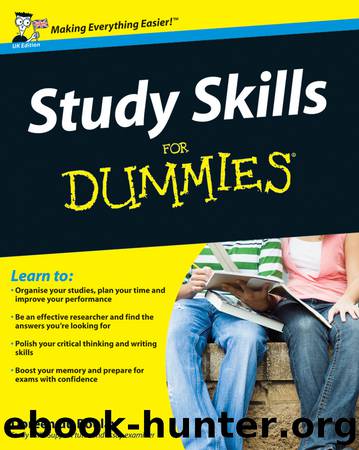Study Skills For Dummies by du Boulay Doreen

Author:du Boulay , Doreen
Language: eng
Format: epub
Publisher: John Wiley & Sons, Ltd.
Published: 2011-02-02T16:00:00+00:00
Information for 1979 (the year the one child per family rule was introduced) was impossibleto obtain, probably because there was no census in China in that year. This doesn’t have to be a major stumbling block. You might decide to use the 1982 data from www.allcountries.com as a baseline, when there was a census, or use 1964 data as a ‘before’ baseline as well – after all, it would’ve taken a while for the one-child policy to have an effect on the working population age band (logically) and you may want to check on how effective the implementation of the one-child policy was.
Some statistics use different age bands (over 60 instead of over 65, for instance). The statistics available from four sources vary, as do the dates they refer to. From the census data there seem to be trends, so you may decide to present the information in a graph and include future projections, as the essay title refers to the future. A falling birth rate and a rising retired population would theoretically, at some point, become critical. When that happens may be another question to ask the literature. This gives you a possible theoretical perspective or base-line calculation to use.
Notes like these set you off on your next line of enquiry.
Often, no precise agreement exists over numbers, so the safest way to describe them is to use adverbs such as approximately, about or roughly, using an average or summary of the numerical data. Realising that numbers are flexible, approximate and not fixed in stone, is a useful lesson to learn. It’s always worth questioning any number that doesn’t seem to make sense, just as you would at the checkout in the supermarket. It would be surprising if all the sources did agree on exactly the same number, unless they were all quoting from the same base source. The differences may be due to the methodology used. This is another question that may be worth noting for your analysis or comment section later.
Studying is about learning by thinking, asking questions and thinking again – or you may say, pondering and reflecting. Note-taking – and what and how you do so – is a core skill in this process. This is how you bring your unique contribution to learning, which you show in the end product, your writing (or presentation.) If you use the strategy I’ve suggested, it then leads you to the next strategy, level of questions, answers (or lack of), analysis and comment.
Summary skills
The ability to summarise information is an important skill and attracts credit in your writing. Taking table notes (as in Table 11-1) helps you to summarise information from several sources by reading horizontally across. The answers from the literature to question 5 ‘ What percentage of the Chinese Population is over retirement age ?’are shown in Table 11-1, point 5, but the data uses different age bands (over 60 and over 65), but the figure of 8 per cent for 2008 looks well supported by the earlier figures from the other sources.
Download
This site does not store any files on its server. We only index and link to content provided by other sites. Please contact the content providers to delete copyright contents if any and email us, we'll remove relevant links or contents immediately.
Spare by Prince Harry The Duke of Sussex(5140)
Navigation and Map Reading by K Andrew(5133)
Tuesdays with Morrie by Mitch Albom(4729)
Machine Learning at Scale with H2O by Gregory Keys | David Whiting(4258)
Cracking the GRE Premium Edition with 6 Practice Tests, 2015 (Graduate School Test Preparation) by Princeton Review(4248)
Never by Ken Follett(3882)
Goodbye Paradise(3761)
What It Really Takes to Get Into Ivy League and Other Highly Selective Colleges by Hughes Chuck(3716)
Harry Potter and the Prisoner of Azkaban (Book 3) by J. K. Rowling(3323)
Fairy Tale by Stephen King(3307)
Pledged by Alexandra Robbins(3152)
Kick Ass in College: Highest Rated "How to Study in College" Book | 77 Ninja Study Skills Tips and Career Strategies | Motivational for College Students: A Guerrilla Guide to College Success by Fox Gunnar(3099)
A Dictionary of Sociology by Unknown(3044)
Sapiens and Homo Deus by Yuval Noah Harari(3029)
Reminders of Him: A Novel by Colleen Hoover(3010)
The Social Psychology of Inequality by Unknown(2987)
Graduate Admissions Essays, Fourth Edition: Write Your Way into the Graduate School of Your Choice (Graduate Admissions Essays: Write Your Way Into the) by Asher Donald(2890)
Will by Will Smith(2872)
Zero to Make by David Lang(2753)
